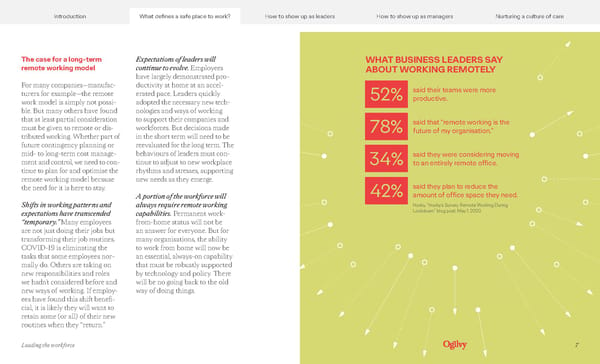Introduction How to show up as leaders How to show up as managers Nurturing a culture of care Introduction What defines a safe place to work? How to show up as leaders How to show up as managers Nurturing a culture of care The case for a long-term Expectations of leaders will WHAT BUSINESS LEADERS SAY remote working model continue to evolve. Employees ABOUT WORKING REMOTELY have largely demonstrated pro- For many companies—manufac- ductivity at home at an accel- said their teams were more turers for example—the remote erated pace. Leaders quickly 52% productive. work model is simply not possi- adopted the necessary new tech- ble. But many others have found nologies and ways of working that at least partial consideration to support their companies and said that “remote working is the must be given to remote or dis- workforces. But decisions made 78% future of my organisation.” tributed working. Whether part of in the short term will need to be future contingency planning or reevaluated for the long term. The mid- to long-term cost manage- behaviours of leaders must con- said they were considering moving ment and control, we need to con- tinue to adjust to new workplace 34% to an entirely remote office. tinue to plan for and optimise the rhythms and stresses, supporting remote working model because new needs as they emerge. the need for it is here to stay. 42% said they plan to reduce the A portion of the workforce will amount of office space they need. Shifts in working patterns and always require remote working Hoxby, “Hoxby’s Survey: Remote Working During expectations have transcended capabilities. Permanent work- Lockdown,” blog post, May 1, 2020. “temporary.” Many employees from-home status will not be are not just doing their jobs but an answer for everyone. But for transforming their job routines. many organisations, the ability COVID-19 is eliminating the to work from home will now be tasks that some employees nor- an essential, always-on capability mally do. Others are taking on that must be robustly supported new responsibilities and roles by technology and policy. There we hadn’t considered before and will be no going back to the old new ways of working. If employ- way of doing things. ees have found this shift benefi- cial, it is likely they will want to retain some (or all) of their new routines when they “return.” Leading the workforce 7
 New Way of Working Page 6 Page 8
New Way of Working Page 6 Page 8